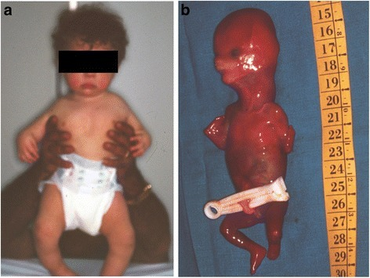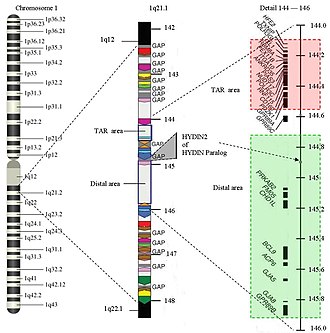| TAR syndrome | |
|---|---|
| Other names: Thrombocytopenia with absent radius syndrome | |
TAR syndrome (thrombocytopenia with absent radius) is a rare genetic disorder that is characterized by the absence of the radius bone in the forearm and a dramatically reduced platelet count.[1]
Signs and symptoms[edit | edit source]
The clinical presentations of this condition are the following:
- Presents with symptoms of thrombocytopenia, or a lowered platelet count, leading to bruising and potentially life-threatening hemorrhage.[2]
- Absence of the radius bone in the forearm with preservation of the thumb[citation needed].
Other common links between people with TAR syndrome include anemia, heart problems, kidney problems, knee joint problems, and frequently milk allergy. Different cases with leukemia in patients with TAR are described in.[clarification needed][3]
Genetics[edit | edit source]
This condition requires mutations in both chromosomes[clarification needed].[4] The first mutation is inheritance of a 1q21.1 deletion and the second is in the remaining in the RBM8A gene
. Approximately 95% of TAR patients have one non-functional copy of the RBM8A gene.[5][6]
Diagnosis[edit | edit source]
In terms of the diagnosis for TAR syndrome the following are done:[7]
- Physical exam
- Skeletal X-ray
- Blood test
Treatment[edit | edit source]
Treatments range from platelet transfusions[1] to surgery aimed at either centralizing the hand over the ulna to improve functionality of the hand or aimed at 'normalizing' the appearance of the arm, which is much shorter and 'clubbed'.[citation needed] There is some controversy surrounding the role of surgery[citation needed]. The infant mortality rate has been curbed by new technology, including platelet transfusions, which can even be performed in utero[citation needed]. The critical period is the first and sometimes second year of life[citation needed]. For most people with TAR, platelet counts improve as they grow out of childhood.[citation needed]
Epidemiology[edit | edit source]
The incidence is 0.42 per 100,000 live births[citation needed].
History[edit | edit source]
In 1929 Greenwald and Sherman{{ described the first patient with TAR Syndrome.[8] 40 years later Hall collected 40 cases and introduced the name "Thrombocytopenia with absent radius".[9] In 1988 Hedberg published an article with 100 cases.[10]
References[edit | edit source]
- ↑ 1.0 1.1 Toriello HV (December 2016). "Thrombocytopenia Absent Radius Syndrome.". In Adam MP, Ardinger HH, Pagon RA, Wallace SE, Bean LJ, Stephens K, Amemiya A, Toriello HV (eds.). GeneReviews [Internet]. University of Washington, Seattle. PMID 20301781. Archived from the original on 2020-09-18. Retrieved 2021-05-16.
- ↑ Manukjan G, Bösing H, Schmugge M, Strauß G, Schulze H (November 2017). "Impact of genetic variants on haematopoiesis in patients with thrombocytopenia absent radii (TAR) syndrome". primary. British Journal of Haematology. 179 (4): 606–617. doi:10.1111/bjh.14913. PMID 28857120.
- ↑ Jameson-Lee M, Chen K, Ritchie E, Shore T, Al-Khattab O, Gergis U (February 2017). "Acute myeloid leukemia in a patient with thrombocytopenia with absent radii: A case report and review of the literature". primary. Hematology/Oncology and Stem Cell Therapy. 11 (4): 245–247. doi:10.1016/j.hemonc.2017.02.001. PMID 28259746.
- ↑ Brodie SA, Rodriguez-Aulet JP, Giri N, Dai J, Steinberg M, Waterfall JP, Roberson D, Ballew BJ, Zhou W, Anzick SL, Jiang Y, Wang Y, Zhu YJ, Meltzer PS, Boland J, Alter BP, Savage SA (2019) 1q21.1 deletion and a rare functional polymorphism in siblings with thrombocytopenia-absent radius-like phenotypes. Cold Spring Harb Mol Case Stud 5(6)
- ↑ Albers CA, Newbury-Ecob R, Ouwehand WH, Ghevaert C (June 2013). "New insights into the genetic basis of TAR (thrombocytopenia-absent radii) syndrome". review. Current Opinion in Genetics & Development. 23 (3): 316–23. doi:10.1016/j.gde.2013.02.015. PMID 23602329.
- ↑ Al-Qattan MM (November 2016). "The Pathogenesis of Radial Ray Deficiency in Thrombocytopenia-Absent Radius (TAR) Syndrome" (PDF). review. Journal of the College of Physicians and Surgeons Pakistan. 26 (11): 912–916. PMID 27981927. Archived (PDF) from the original on 2018-11-23. Retrieved 2021-05-16.
- ↑ RESERVED, INSERM US14-- ALL RIGHTS. "Orphanet: Thrombocytopenia absent radius syndrome". www.orpha.net. Archived from the original on 4 March 2021. Retrieved 11 August 2021.
- ↑ Greenwald HM, Sherman I (1928). "Congenital essential thrombocytopenia". primary. Am J Dis Child. 38 (6): 1245. doi:10.1001/archpedi.1929.01930120123011.
- ↑ Hall JG, Levin J, Kuhn JP, Ottenheimer EJ, van Berkum KA, McKusick VA (November 1969). "Thrombocytopenia with absent radius (TAR)". primary. Medicine. 48 (6): 411–39. doi:10.1097/00005792-196948060-00001. PMID 4951233. S2CID 23832858.
- ↑ Hedberg VA, Lipton JM (1988). "Thrombocytopenia with absent radii. A review of 100 cases". review. The American Journal of Pediatric Hematology/Oncology. 10 (1): 51–64. doi:10.1097/00043426-198821000-00010. PMID 3056062.
Further reading[edit | edit source]
- Goldfarb CA, Wall L, Manske PR (September 2006). "Radial longitudinal deficiency: the incidence of associated medical and musculoskeletal conditions". primary. The Journal of Hand Surgery. 31 (7): 1176–82. doi:10.1016/j.jhsa.2006.05.012. PMID 16945723.
External links[edit | edit source]
- Thrombocytopenia Absent Radii research study of Inherited Bone Marrow Failure Syndromes (IBMFS) Archived 2021-03-01 at the Wayback Machine
- GeneReview/NCBI/NIH/UW entry on Thrombocytopenia Absent Radius Syndrome Archived 2010-05-27 at the Wayback Machine
| Classification |
|---|

